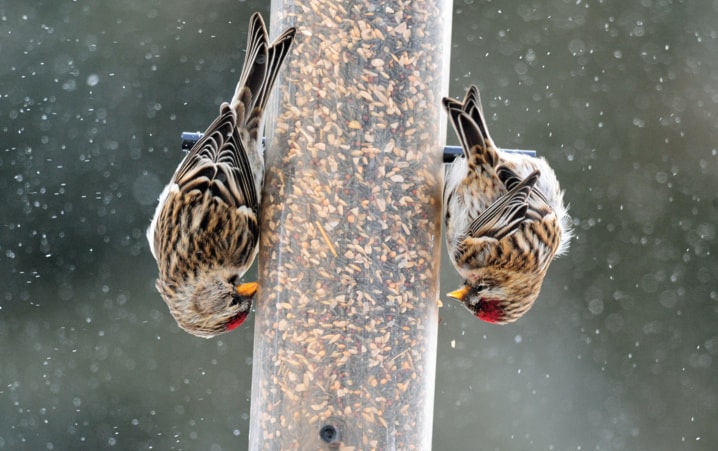Redpolls are one of the most interesting and entertaining of our backyard neighbours. Considered to be the hardiest birds on the planet, these feisty little circumpolar finches breed in the Arctic and spend their winters in balmy Alberta!
Redpolls are easy to identify because they are the only small winter birds with red crowns. Their vocalizations are a combination of pleasant soft trills and twitters, and a drawn-out sweeeeee call.
Flocks of redpolls seem to appear suddenly, usually in mid-November. Although they are considered to be irruptive winter finches (abundant some years and not others), redpolls are unique because they usually follow a two-year cycle.
If weather conditions are favourable on their Arctic breeding grounds, redpolls will often raise two broods in one season. If the resulting rapid population increase coincides with a year that their principal food trees (birches and other shrubs) don’t produce many seeds, the birds have no choice but to move south to lower latitudes. When they show up at our backyard feeders in mid-October, chances are there wasn’t much for them to eat up north. If food is plentiful across their southern wintering grounds, redpolls will sometimes remain until late May. However, most depart back to the tundra around the end of March.
Redpolls have the remarkable ability to able to survive for up to 20 hours without access to food, even at temperatures that can drop to as low as minus 54C! They obtain sufficient energy during this icy fast by storing seeds in specially designed esophageal pouches. They pack these pouches with seeds before they retire for the long cold night. The seeds are digested slowly, providing them with sufficient energy to maintain their core body temperature at about 40C. Their internal temperature can be 73C warmer than the surrounding air, with the two extremes being separated by only a .6-cm thick layer of feathers.
If you have redpolls at your feeders, you will notice that the males’ chests are becoming a more intense red colour as the breeding season approaches. You may also notice that the birds seem to be increasingly restless during these last few days before they depart. Within a week or so these frenetic little finches will be winging their way northward to the far reaches of the Arctic tundra.
Myrna Pearman is the biologist at Ellis Bird Farm. She can be contacted at mpearman@ellisbirdfarm.ca
